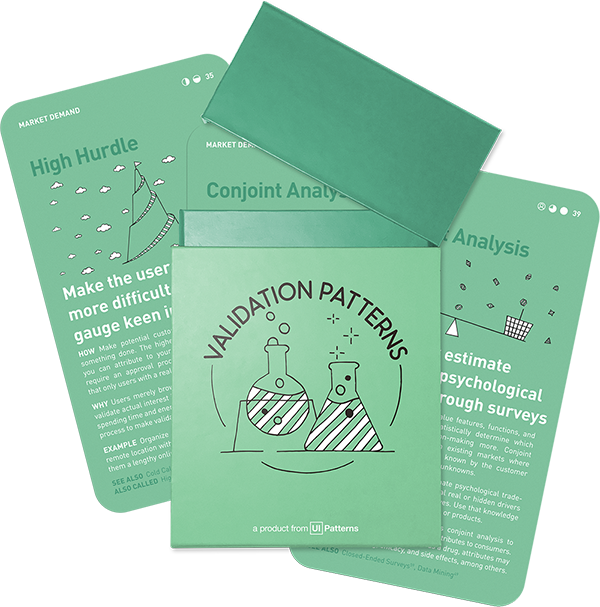Evidence strength
Relevant metrics: Acquisition, Activation, Customer feedback, Cost
Validates: Feasibility, Viability, Desirability
How: Offer your early-stage functioning product or service in an open (public) or closed (private) beta to interested users. Consider limiting the number of active beta users Ð either to make your product seem more scarce and interesting or to iteratively receive fresh feedback to onboarding flows.
Why: Launching your product before fixing bugs, performance issues, and scalability issues will put your product in the hands of customers earlier and will thus provide feedback on implementation and market demand faster.
This experiment is part of the Validation Patterns printed card deck
A collection of 60 product experiments that will validate your idea in a matter of days, not months. They are regularly used by product builders at companies like Google, Facebook, Dropbox, and Amazon.
Get your deck!Before the experiment
The first thing to do when planning any kind of test or experiment, is to figure out what you want to test. To make critical assumptions explicit, fill out an experiment sheet as you prepare your test. We created a sample sheet for you to get started. Download the Experiment Sheet.
Why should I conduct a beta test?
Beta testing can help you discover and understand the actual experience end-users interacting with your product rather than the one you had intended for them.
- Assess problem-solution fit. Beta testing allows for greater assurance of a product’s real-world compatibility by utilizing a combination of real platforms for testing on a wide range of devices, operating systems, and browsers.
- Uncover hidden bugs and gaps. No matter how hard you tried, there is no way you can enact what your end users will experience. You simply don’t have access to the same platforms your end-users are using. Even if you have an internal testing team, they may not be able to identify all bugs or gaps in the final product – partly due to the fact that your users will use and understand your product in other ways than you had planned for them.
- Analyze the impact of known issues. During beta testing, known issues that were previously accepted may be revealed to have a greater negative impact on the user experience. This allows for the analysis of the impact of these issues on the entire product, and for any necessary adjustments to be made to ensure a successful business outcome.
- Get a clear prioritization of important user problems. Once you put your product in the hands of real users, chances are that the main user problems are differen’t from what you had imagined before testing. Details that you have spent months worrying about suddenly become minor, and small sidenotes suddenly become the driving force of future iterations. You won’t know until you test and get your product out of the building.
More than bug hunting
Launching your product in beta, knowingly releasing an unfinished product with known bugs and unknown bugs to users, is a great way to identify and rid its most critical bugs, usability friction, and bad performance before releasing it in its finished version. However, releasing your product in beta will provide a number of other possible benefits.
- Validating problem/solution fit. Do people care about the pains and gains of your problem and does your product address each one in a way they understand? And does that match with the value proposition of your proposed product?
- Raising product awareness. Beta testing can be a marketing strategy – creating initial buzz and momentum among your target audience that can pave the way for better reception when the product is officially relased.
Recruiting beta-users
If you are aiming for receiving enough qualitative and constructive feedback to fix your product, a rule of thumb is that 200-300 users will do. However, if your goal is more around creating momentum, creating awareness, and perhaps building an email list of users committed to being interested, you want as mamny as possible.
Common sources for recruiting beta-testers are:
- Beta-testing as a service. Services like BetaList, BetaTesting.com provide Beta testing as a service. If you don’t already have an email list or social precense, these websites help with people willing to test.
- Social Media. Twitter, Reddit, LinkedIn, Facebook, and other social media platforms can be a great place to attract users of a specific target audience. Paying for reach can help you choose the exact demographic you are looking for.
- Startup directories. Early adopters looking to hunting for the next big thing can be found at directories such as BetaBound
- Your personal contacts. Ask friends and family or people in your professional network to test your product.
Incentivising feedback
Depending on whether you are conducting a beta-test to test problem/solution fit or simply to raise awareness about your product, you will want to consider rewarding beta testers for their time and effort to analyze, critize, and make suggestions for changes. Gifting beta testers is also a great way to help build brand loyalty so that the next time you need to test a product, you have plenty of willing testers around.
If you do chose to provide incentives, you will want to only reward active and complete contributions. You might also consider keeping the gifting a surprise till the very end of the test, so that you don’t bias your findings.
Common ways to acknowledge the efforts users took to work hard to improve your product include:
- Gift cards or cash. Real monetary awards that is comparable to the effort put in. The amount will vary in size depending on the target audience.
- Early bird pricing. To keep beta testers as loyal users, several services offer beta testers or early adopters to lock in at a favorable low price for ever, leading users to accept an inferior product for a reasonable price for a longer time.
- Founding members. Create a special page where the name of the early beta-testers will be listed, forever, as an eternal thank you for your efforts.
Capturing feedback
There are several ways in which you can collect feedback from your beta testers:
- Reporting bugs. Let beta testers spot and eliminate bugs and other unnoticed issues when you’re still in development mode.
- Submitting feature requests. As beta testers use your product, they might encounter things they wished they could do. Allow users to let you know. The closer to the context you can let them tell you, the better (hint: use micro-surveys).
- Discussion forums. Consider opening a closed forum for beta testers to openly provide insights into what they are experiencing. Getting other beta testers to comment on each others findings, can be a great way to both nuance the findings and test whether an issue or request is a recurring phenomenon or not.
- Let the data speak. Make sure to define what beta test sucess and failure looks like before you endeavour into one. What numbers to you expect to see in your metrics, how far into your product do you expect users to go, and how do you expect users to use your features.
Designing a successful beta launch program
The beta launch test phase is a crucial step in the development of any product, as it allows for a comprehensive evaluation of the user experience before the final release. To ensure a successful beta launch, consider the following guidelines:
- Define the duration of the test. Before beginning the beta test, decide on the number of days for which the beta version will be made available to testers.
- Provide clear test instructions. Consider letting users know what you in particular want them to try out or incentivise certain behavior to force users going down a specific path.
- Know your end-game before you start. Clearly establish the objectives and metrics of your beta testing phase, and ensure that stakeholders are aware of the Go/No-go strategy.
- Define Your Audience. Identify a small yet diverse group of beta testers that align with your end-goals, and take into account factors such as location, functionality, company size, customer health, and market.
- Distribution of your software. Develop a secure and efficient method for distributing your software to beta testers, taking into account platform-specific requirements and any potential approval processes.
- Define Your Team. Assemble a team of key partners and clearly define their roles and responsibilities in the beta testing phase.
- Educate Your Testers. Provide clear instructions and guidance to beta testers to ensure they understand their role and how to provide effective feedback.
- Security. Implement robust security measures to protect sensitive information and data during the beta testing phase.
- Internal transparency. Ensure internal transparency by sharing progress and feedback with all relevant parties.
- Collect feedback. Develop a system for collecting and organizing feedback from beta testers.
- Share the feedback. Share feedback with relevant teams and stakeholders to inform and guide product development.
- Thank your customers. Show appreciation and gratitude to beta testers for their participation and feedback.
After the experiment
To make sure you move forward, it is a good idea to systematically record your the insights you learned and what actions or decisions follow. We created a sample Learning Sheet, that will help you capture insights in the process of turning your product ideas successful. Download the Learning Sheet.
Popular tools
The tools below will help you with the Beta Launch play.
-
HotJar
Hotjar is an anlytics service that lets you track user activity, replay their actions, and add micro-surveys that ask about specific behavior.
-
Product Hunt
Product Hunt lists and promotes exciting new products.
-
BetaList
BetaList is a community of makers and early adopters showcasing their startups and exchanging feedback.
-
BetaTesting
Beta test with real people in real environments. You get real-world engagement data & feedback to help scale your product.
-
Betabound
A directory of beta testing opportunities
Examples
Hotjar
Through a 7 month private beta program, HotJar managed to entice 18,000 beta testers (7,000 active) that created over 6000 conversations with the HotJar team, 681 feature suggestions, 231 bugs addressed, and over 1000 paying customers in the first month.
Source: The Hotjar story (part 1) – from idea to 60,000 beta signups in 6 months
Related plays
- Beta Testing of Your Product: 6 Practical Steps to Follow by Vimal Maheedharan
- 10 Tips for Launching a Successful Beta Program by Ana De Aza

